Input interpretation

triglyme
Chemical names and formulas
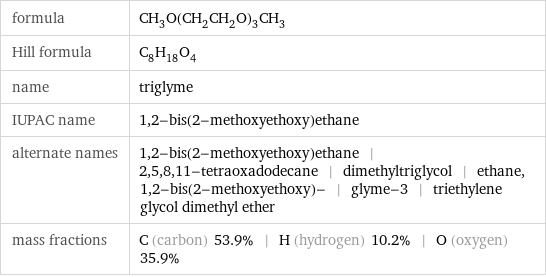
formula | CH_3O(CH_2CH_2O)_3CH_3 Hill formula | C_8H_18O_4 name | triglyme IUPAC name | 1, 2-bis(2-methoxyethoxy)ethane alternate names | 1, 2-bis(2-methoxyethoxy)ethane | 2, 5, 8, 11-tetraoxadodecane | dimethyltriglycol | ethane, 1, 2-bis(2-methoxyethoxy)- | glyme-3 | triethylene glycol dimethyl ether mass fractions | C (carbon) 53.9% | H (hydrogen) 10.2% | O (oxygen) 35.9%
Lewis structure
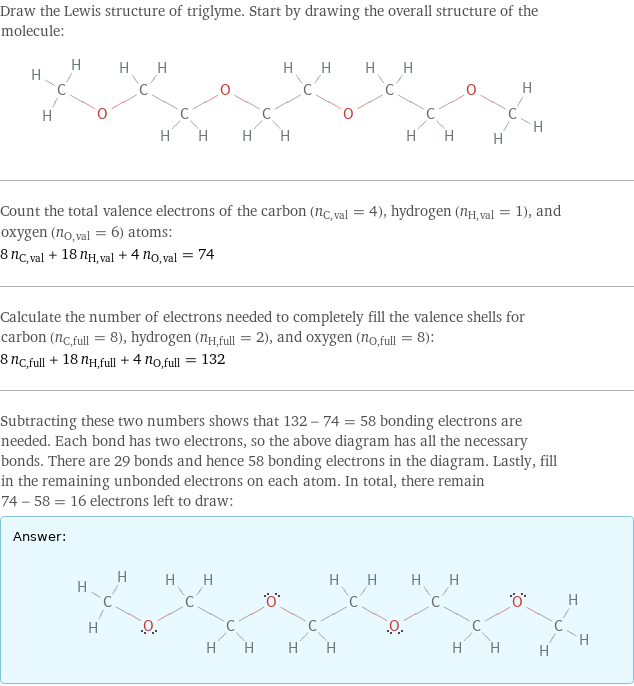
Draw the Lewis structure of triglyme. Start by drawing the overall structure of the molecule: Count the total valence electrons of the carbon (n_C, val = 4), hydrogen (n_H, val = 1), and oxygen (n_O, val = 6) atoms: 8 n_C, val + 18 n_H, val + 4 n_O, val = 74 Calculate the number of electrons needed to completely fill the valence shells for carbon (n_C, full = 8), hydrogen (n_H, full = 2), and oxygen (n_O, full = 8): 8 n_C, full + 18 n_H, full + 4 n_O, full = 132 Subtracting these two numbers shows that 132 - 74 = 58 bonding electrons are needed. Each bond has two electrons, so the above diagram has all the necessary bonds. There are 29 bonds and hence 58 bonding electrons in the diagram. Lastly, fill in the remaining unbonded electrons on each atom. In total, there remain 74 - 58 = 16 electrons left to draw: Answer: | |
3D structure
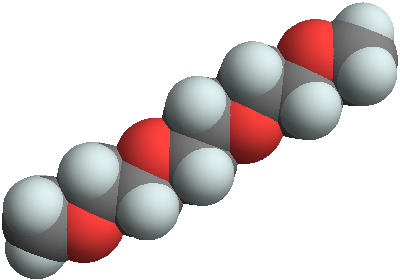
3D structure
Basic properties
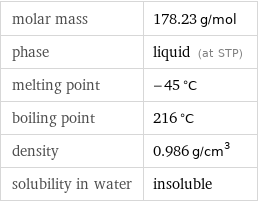
molar mass | 178.23 g/mol phase | liquid (at STP) melting point | -45 °C boiling point | 216 °C density | 0.986 g/cm^3 solubility in water | insoluble
Units

Hydrophobicity and permeability properties

predicted LogP hydrophobicity | -0.08 predicted LogS | -1.03
Basic drug properties

approval status | experimental | small molecule
Liquid properties (at STP)
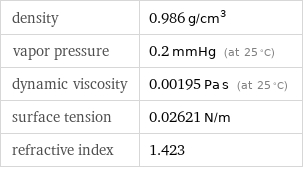
density | 0.986 g/cm^3 vapor pressure | 0.2 mmHg (at 25 °C) dynamic viscosity | 0.00195 Pa s (at 25 °C) surface tension | 0.02621 N/m refractive index | 1.423
Units

Thermodynamic properties
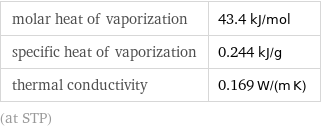
molar heat of vaporization | 43.4 kJ/mol specific heat of vaporization | 0.244 kJ/g thermal conductivity | 0.169 W/(m K) (at STP)
Chemical identifiers
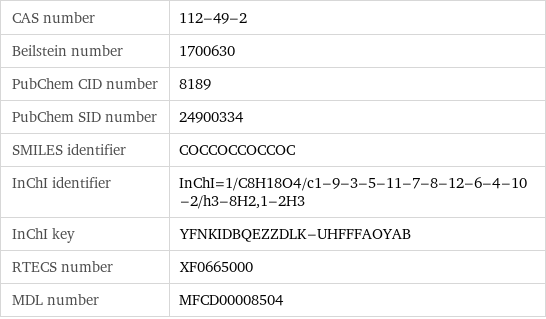
CAS number | 112-49-2 Beilstein number | 1700630 PubChem CID number | 8189 PubChem SID number | 24900334 SMILES identifier | COCCOCCOCCOC InChI identifier | InChI=1/C8H18O4/c1-9-3-5-11-7-8-12-6-4-10-2/h3-8H2, 1-2H3 InChI key | YFNKIDBQEZZDLK-UHFFFAOYAB RTECS number | XF0665000 MDL number | MFCD00008504
Safety properties
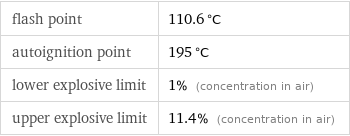
flash point | 110.6 °C autoignition point | 195 °C lower explosive limit | 1% (concentration in air) upper explosive limit | 11.4% (concentration in air)

DOT hazard class | 3 DOT numbers | 2924